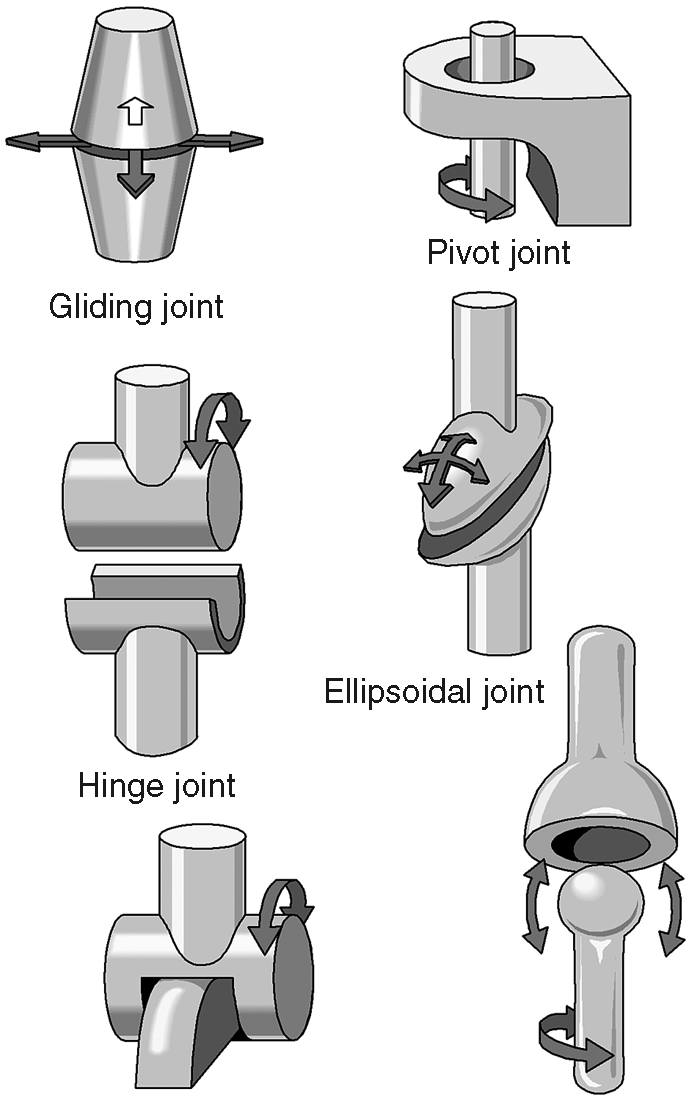Anatomy and Physiology: Hinges, Pivots, and Saddles … Oh My!
Hinges, Pivots, and Saddles … Oh My!
Despite all their similarities, there are six basic types of synovial joints (see Figure 7.1). What makes these types different is the type of motion that is possible at each. What follows is a brief description of each type, with examples, of course! Keep these joints in mind, as they will help you to learn the movements later.

Figure 7.1The six types of synovial joints, and the type of motion possible at each. (LifeART©1989-2001, Lippincott Williams & Wilkins)
Slipping and Sliding
A gliding (or arthrodial) joint, which is the simplest type of diarthrosis possible, only allows side-to-side motion. This is obviously very limited, but it definitely has its uses. These joints are found between the carpals and between the tarsals. Individually they may not provide much movement, but together they provide great flexibility. Gliding joints can also be found at both ends of the clavicles (scapula and sternum), and at both ends of the ribs (sternum and vertbra).
Like Opening a Door
A far greater amount of movement is possible in a hinge (or ginglymus) joint, but it is a limited movement nonetheless. Hinge joints act like, well, hinges! The motion is called angular, but the limitation is that hinge joints allow motion along only one plane. Hinge joints are found all over the body. Most people think of the elbow and the knee, but hinge joints are also found between the phalanges of the fingers and toes, in the ankle, and between the occipital bone and the atlas vertebra (a.k.a. C1).
Side to Side
A pivot (or trochoid) joint also allows a lot of movement, this time called rotational movement; but once again it is limited to a single plane. One characteristic of the bones at such joints is that they have a rounded surface. One example is the proximal end of the radius (which is shaped like a wheel), and of the ulna (shaped like a wheel well), allowing you to flip your hand over. Another example is between the atlas vertebra and the dens (shaped like a round peg) of the axis vertebra; without this you wouldn't be able to shake your head and say “No!”
Ellipsoidal
An ellipsoidal joint has an advantage over hinge joints in that they can move on two planes (side to side, and back and forth), rather than just one. These joints are also called condyloid because they are a combination of an elliptical cavity and a rounded condyle. One example of this is the articulation between the cavity at the distal end of the radius, and two of the carpals (scaphoid and lunate). Ellipsoidal joints are also found where the proximal phalanges meet the metacarpals and metatarsals.
Back in the Saddle Again
A saddle joint is a modified ellipsoidal joint, but with a pair of bones in a rider and saddle shape. The first metacarpal (of the thumb) and the trapezium (on of the carpals) form just such a joint. A saddle joint has a much wider range of flexibility, including movement on two axes (biaxial). One form of movement, called circumduction, should be well known to you if you've ever twiddled your thumbs.
Sock It to Me, Lucille!
Of all the joints in the body, this is, by far, the most flexible. If you have ever had a G.I. Joe doll, or a Barbie action figure, and you have ever changed the clothes of these exceedingly anatomically incorrect toys—no one is really shaped that way, especially in terms of proportion—you have seen this type of joint firsthand. In both the toy hip and toy shoulder, as in humans, there is a ball-like shape at the proximal end of the arm and leg that fits into the plastic shoulder and hip.
In humans, the ball is the head of the humerus and the head of the femur; the head of the humerus fits nicely into the rounded glenoid cavity of the scapula, whereas the head of the femur fits into the even more rounded acetabulum of the pelvic coxa, or pelvis bone. Imagine swinging your arm to throw the third strike in the bottom of the ninth, clinching your victory in game seven of the World Series, and you will have used a movement that is a wonder of the ball-and-socket joint: circumduction. A quick look at the intense number of tendons and ligaments at each of these joints, but especially in the hip, will explain why people are far more likely to dislocate their shoulders.

Excerpted from The Complete Idiot's Guide to Anatomy and Physiology © 2004 by Michael J. Vieira Lazaroff. All rights reserved including the right of reproduction in whole or in part in any form. Used by arrangement with Alpha Books, a member of Penguin Group (USA) Inc.
To order this book direct from the publisher, visit the Penguin USA website or call 1-800-253-6476. You can also purchase this book at Amazon.com and Barnes & Noble.
